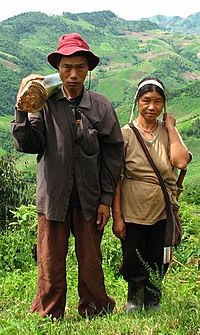
Photo from wikipedia
Abstract From its modern origin over sixty years ago, generative grammar has attempted to characterize the human “faculty of language” as an evolvable trait–a particular phenotype . This phenotype has… Click to show full abstract
Abstract From its modern origin over sixty years ago, generative grammar has attempted to characterize the human “faculty of language” as an evolvable trait–a particular phenotype . This phenotype has a species-specific genetic basis, what biologists typically call a genotype . There are many puzzling questions about the nature of the human language genotype and phenotype, some of which are addressed in the recent book, Why Only Us ( Berwick & Chomsky 2016 ). Among the most puzzling are the following: why does language occur only in humans, appearing relatively rapidly and recently in evolutionary terms, along with no apparent genomic change since its emergence? Why Only Us suggested that the answer to this question is that the required evolutionary innovation was simple, with most of its underpinnings antecedently in place. The key evolutionary novelty yielding the human language phenotype–perhaps the only innovation, putting to one side an important mystery regarding the origin of human concepts that were called “word-like atomic elements”–is an operation called Merge . Merge builds a “discrete infinity of structured expressions that are interpretable in a definite way by the conceptual-intentional system of thought and action, and by a sensory-motor system for externalization”–in short, thought linked with sound/sign ( Chomsky, 2016 ). This may be called the “Basic Property” (BP) of human language, and it is a short answer to the question of “What evolved” for human language. The BP gives rise to the language faculty: the ability for any person to acquire any human language. We consider the language faculty the proper phenotype for analysis, and its underlying genomics, the corresponding genotype. Much confusion has arisen by conflating the properties of individually realized languages with the design of the language faculty itself, because this leads to a very different conception of the language phenotype, one inextricably linked to articulatory or vocal output modalities–the externalization of language. More broadly, WOU framed the basic evolutionary puzzles about the evolution of the language faculty in the form of answers to five additional questions: Who evolved the BP? Where and when did the BP evolve? How did it evolve? And, finally, Why? Since its publication, new evidence has accumulated in support of WOU's basic thesis, though as always many important questions remain open. Here we review this very recent evidence focusing on basic evolutionary issues, including a recurrent, but we think misguided, effort to account for the properties of the language faculty by means of cultural-biological interaction. We argue that this latter effort fails in all respects–it does not account for the properties of the language faculty, failing to rule out languages that are known to be “impossible” on other, empirical grounds, including brain imaging; and does not even make successful empirical predictions about diachronic language change.
Journal Title: Journal of Neurolinguistics
Year Published: 2017
Link to full text (if available)
Share on Social Media: Sign Up to like & get
recommendations!